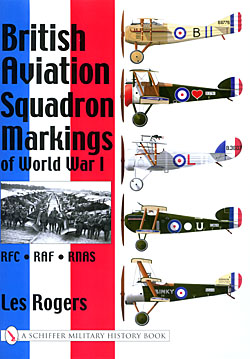 British Aviation Squadron Markings of World War I British Aviation Squadron Markings of World War I
RFC/RAF/RNAS
Les Rogers
Schiffer, ©2001
296 Pages, Hardbound
ISBN 0-7643-1284-7
MSRP $69.95 I’ve been anxiously awaiting the release of this book for some time now, and now it’s finally here. If you have ever wondered what all those white markings meant on those PC10 biplanes of World War One, this book will answer those questions. The book starts out with a short introduction to squadron markings, including flight and personal markings as well. After another short intro on experimental camouflage schemes, the book jumps right into the squadron markings. This is the meat of the book, broken down by squadrons. For instance, under No. 18 Squadron RFC is the following: "Went to France on 19th November, 1915, equipped with Vickers Gun Buses but in April 1916 they were replaced with F.E.2bs. Squadron Markings None allotted, but when the B.E.2c squadrons were given squadron markings on 23rd April, 1916, the O.C. of 18 Squadron asked permission to paint a red triangle on the nacelle behind the lacing. The reply on 28th April was “this is unnecessary as the F.E.s are distinct enough!” However, on 22nd September, 1916, F.E.2b 6937 was lost over the lines and under the paint on the nose of the nacelle could be seen a light coloured diamond, which could have been a version of the proposed unofficial marking. In May/June, 1917 the F.E.s were withdrawn and the squadron re-equipped with D.H.4s. No record of markings for this period. Squadron Markings Allotted on 26th August, 1917, a white square on the fuselage side behind the cockade. This was painted fairly large. Flight Markings “A” Flight used red wheel covers.
“B” Flight used white wheel covers.
“C” Flight used blue wheel covers. Individual Markings “A” Flight used A, B, C, D, E, F; spare aircraft used G.
“B” Flight used 1, 2, 3, 4, 5, 6; spare aircraft used 7.
“C” Flight used S, T, U, V, W, X; spare aircraft used Y. Painted in white behind the squadron marking, on the centre section, and sometimes on the top decking. After the deletion of squadron markings the same individual markings were used."
And this was a fairly short entry! This same style is carried throughout
the whole book, and there seems to be at least one photo for each squadron
(often as many as 5 or 6 photos, though). And as if this isn’t good enough,
the last 1/3 of the book is filled with color profiles depicting many
of these interesting markings. If you need any inspiration for building
a WWI British plane, this book will likely overwhelm you with options.
And for those of you who thought PC10 bipes were boring, boy, are you
in for a surprise!
Thanks to Rosemont
Hobby for the review sample.
| 


 



  
 |
 British Aviation Squadron Markings of World War I
British Aviation Squadron Markings of World War I






